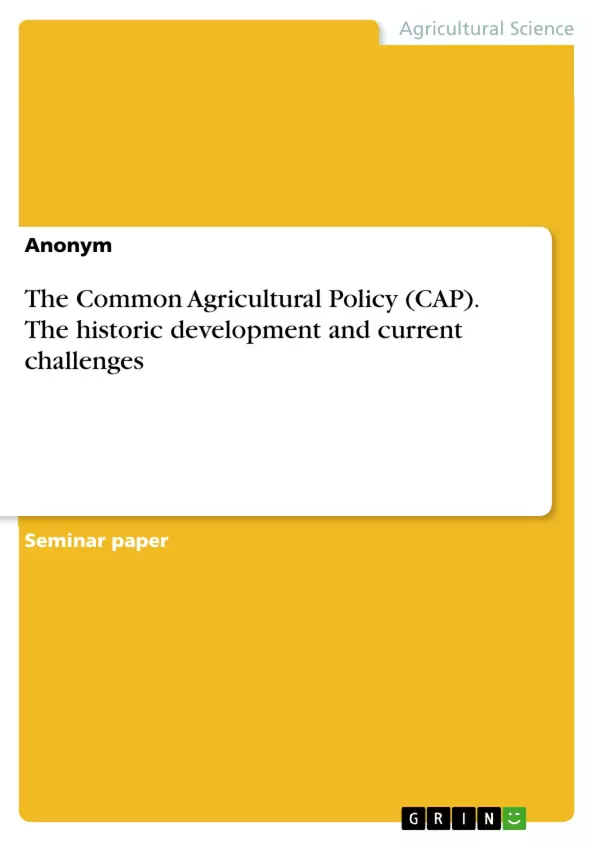This paper deals with the following questions: What is the significance of the Common Agricultural Policy (CAP)? How did the CAP develop in the course of time and which milestones left their mark on the regulations of today’s policy? What are the current problems and which challenges does the CAP have to respond to in the future? How will the development continue?
As a researcher the topic is of great interest as it concerns every European tax payer, the environmental change depends in certain aspects on the policy of the CAP as well as the quality of the European agricultural products. It’s a prevalent topic which not every citizen is fully aware of and whose effects should be examined more in detail.
Agriculture has many important needs to satisfy in the population and to ensure a wide range of social tasks: food production, production of biomass for power generation and material use, design and maintenance of cultural landscapes and biotopes, determination of animal welfare or the impact on social and economic structures.
In order to promote these societal tasks of agriculture, the politics should set the framework in such a way that the economic activity of the farmers fulfills common welfare purposes at the same time. This is done by specifying duties as well as by creating incentives. In this regard the CAP of the European Union (=EU) has a great influence. In this context the time has come again for the EU commission to set the Multiannual Financial Framework (=MFF) for the period from 2021 to 2027.
One of the biggest expenditures with about 54 billion euros a year is the CAP which is nowadays hardly criticised for promoting poverty and food security in developing countries through European subsidies. Interventions related to the agricultural policy cause a dilemma due to the fundamental conflict of interest between producers and consumers. On the one hand, the abolishment of the CAP apparently does not have a lot of negative consequences – according to the Joint Research Centre of the European commission the consequential decline of the agricultural production would be insignificant. On the other hand, the CAP does not have a lot of effects that harm its development, but a danger is prevalent that it might fall back into old patterns by e.g. using payments coupled to the production.
Inhaltsverzeichnis (Table of Contents)
- Introduction
- The Common Agricultural Policy
- Definition
- Two-pillar system
- Historic development
- Initial stage: 1950s to 1960s
- Period of crisis: 1970s to 1980s
- MacSharry reform: 1990s
- 2000-2013
- Current challenges
- 2014-2020
- Future prospects
- Conclusion
Zielsetzung und Themenschwerpunkte (Objectives and Key Themes)
This term paper examines the Common Agricultural Policy (CAP) of the European Union (EU), analyzing its historical development, current challenges, and future prospects. It aims to shed light on the significance of the CAP, its evolution over time, and the key issues it faces in the context of environmental change and agricultural production.
- Definition and Objectives of the CAP
- Historic Development of the CAP
- Current Challenges Facing the CAP
- Future Prospects of the CAP
- Impact of the CAP on European Agriculture and Society
Zusammenfassung der Kapitel (Chapter Summaries)
- Introduction: This chapter introduces the significance of agriculture in meeting societal needs and outlines the role of the CAP in shaping the economic activity of farmers within the EU. It also highlights the current debate regarding the CAP and its impact on poverty, food security, and producer-consumer interests.
- The Common Agricultural Policy (CAP): This chapter defines the CAP as a key element of the EU's support policy for the agricultural sector. It outlines its funding mechanisms, including the European Agriculture Guidance and Guarantee Fund (EAGGF) and the European Agriculture Fund for Rural Development (EAFRD). The chapter also explores the evolution of the CAP's objectives, from raising farm incomes and securing food supply to incorporating environmental and ecological considerations.
- Definition: This section provides a comprehensive overview of the CAP, highlighting its role in regulating the agricultural sector within the EU and its significant contribution to the EU budget. It emphasizes the importance of direct payments, market support measures, and rural development initiatives.
- Two-pillar system: This section delves into the "two-pillar system" of financial support within the CAP, which includes direct payments to farmers and measures promoting rural development. It examines the "cross-compliance" requirements associated with direct payments, including adherence to sustainable farming practices, environmental regulations, and animal welfare standards.
- Historic development: This chapter traces the evolution of the CAP, dividing its history into four key periods: the initial stage (1950s-1960s), the period of crisis (1970s-1980s), the MacSharry reform (1990s), and the period from 2000-2013. Each period is examined in terms of its key policy changes, economic context, and impact on European agriculture.
- Initial stage: 1950s to 1960s: This section explores the early development of the CAP, highlighting its focus on raising farm incomes, securing food supply, and promoting technological progress within the agricultural sector.
- Period of crisis: 1970s to 1980s: This section examines the challenges faced by the CAP during a period of economic instability and agricultural surpluses. It explores the adoption of market intervention measures and the implementation of price support systems.
- MacSharry reform: 1990s: This section delves into the landmark MacSharry reform, which introduced a shift from price support systems to direct payments, aiming to address the problem of agricultural surpluses and promote environmental sustainability.
- 2000-2013: This section explores the CAP during the period of the 2000s, focusing on the further development of direct payments, the emphasis on environmental sustainability, and the integration of rural development initiatives.
Schlüsselwörter (Keywords)
The key keywords and focus topics of this work include Common Agricultural Policy (CAP), European Union (EU), agricultural subsidies, rural development, food security, environmental sustainability, and economic policy.
- Quote paper
- Anonym (Author), 2018, The Common Agricultural Policy (CAP). The historic development and current challenges, Munich, GRIN Verlag, https://www.hausarbeiten.de/document/1129931


